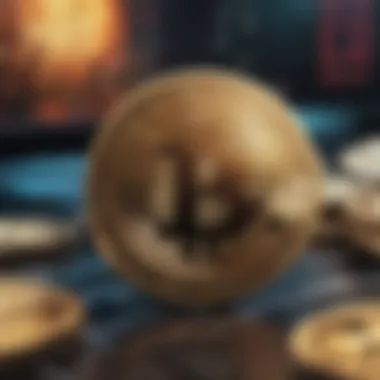Understanding NFT Distribution: Key Insights for Creators


Intro
In the rapidly unfolding universe of cryptocurrency, non-fungible tokens (NFTs) have emerged as a key player, capturing attention from creators, marketers, and collectors alike. Within this dynamic framework, NFT distribution serves as a fundamental pillar that can determine the success or failure of a digital asset. By understanding how NFTs are distributed, stakeholders can refine their approaches, ensuring they capitalize on the opportunities presented by this innovative ecosystem.
As we plunge deeper into the various mechanisms of NFT distribution, we explore its significance, the challenges it presents, and the multifaceted strategies that can be employed. Through this lens, we will not only assess traditional distribution methods but also examine groundbreaking innovations that are reshaping the landscape.
Key Concepts in Cryptocurrency
Before we navigate NFT distribution, it is essential to grasp the underlying elements of cryptocurrency that influence this space.
Definition and Importance
Cryptocurrency, at its core, represents a form of digital or virtual currency that relies on cryptography for security. In simple terms, it is money that exists purely online, free from the grasp of central banks or governments. This decentralization is not just a buzzword; it allows for transparent transactions and greater accessibility. As NFTs are birthed from this technology, understanding cryptocurrency is akin to knowing the roots of a tree that supports the entire structure.
Moreover, NFTs, as unique digital assets, hinge upon this framework to reach potential buyers and collectors. Therefore, the effectiveness of NFT distribution strategies sits squarely on the broader understanding of cryptocurrency.
Blockchain Technology Overview
Central to cryptocurrency is blockchain technology, a distributed ledger system that ensures transparency and immutability. Each transaction is recorded across numerous computers worldwide, making it nearly impossible to alter or hack.
- Transparency: This feature builds trust, as all players can see transaction histories.
- Immutability: Once data is recorded on the blockchain, it cannot be changed, which secures ownership and provenance of NFTs.
Understanding blockchain provides clarity on how NFTs are minted and traded. Each NFT’s journey, from creator to collector, is documented within this digital ledger, reinforcing its authenticity.
"In a world where digital assets reign, the blockchain becomes both the curator and the guardian, ensuring every transaction tells its own story."
Trends and Innovations
In the flurry of NFT distribution, it’s crucial to stay abreast of emerging trends and innovations in the cryptocurrency space. Each development not only shapes the current market landscape but also sets the stage for what is to come.
Emerging Cryptocurrencies
As the NFT market matures, new cryptocurrencies are blossoming, each bringing unique features to the table. While Ethereum remains the cornerstone for many NFTs, alternatives like Flow and Tezos are gaining traction due to their lower transaction fees and eco-friendly approaches. Collectors and artists alike are exploring these new avenues, evaluating their potential for both creativity and financial gain.
Technological Advancements in Crypto
Technological innovations are steering the direction of NFT distribution. For instance, cross-chain solutions allow NFTs to move seamlessly across various blockchains, increasing their accessibility and value.
In addition, layer-2 scaling solutions reduce congestion and costs on high-traffic networks like Ethereum, paving the way for smoother transactions. As the market evolves, staying informed about these advancements can provide a strategic edge to both marketers and investors.
Prelims to NFTs
Non-Fungible Tokens, or NFTs, have become a significant part of the digital narrative, catching the attention of creators, collectors, and investors alike. The importance of understanding NFTs cannot be overstated. In this article, we take a closer look at the impact they have on the digital realm, particularly regarding distribution.
The onset of NFTs has reshaped how we think about ownership and artistry in the digital age. NFTs are not just a trend; they represent a shift in how creators can monetize their work. It allows artists to sell unique pieces of digital art in a way that ensures their originality and value remain uncompromised.
Moreover, for collectors, NFTs offer an innovative way to own unique digital assets. Unlike traditional digital files that can be replicated infinitely, NFTs guarantee authenticity. This characteristic adds a layer of value that echoes the importance of tangible art in the physical world.
Key Elements of Intro to NFTs
- Rethinking Ownership: NFTs challenge conventional notions of ownership in the digital sphere, giving creators more control over their work.
- New Revenue Streams: Understanding NFTs allows creators to access novel revenue streams through direct sales and royalties.
- The Collector's Perspective: For collectors, NFTs represent exclusivity and authenticity, akin to having a verified original painting.
The significance of grasping the fundamentals of NFTs sets the stage for more in-depth discussions on their distribution mechanisms. Understanding these concepts equips readers with the tools they need to navigate the complex and ever-evolving world of digital assets.
Defining Non-Fungible Tokens
In the world of blockchain and cryptocurrency, the term 'non-fungible' signifies that each token is unique and cannot be exchanged on a one-for-one basis with another token. This differentiates NFTs from cryptocurrencies like Bitcoin or Ethereum, which are fungible, meaning they are interchangeable.
A non-fungible token encapsulates specific digital or real-world assets by recording essential metadata—like ownership, provenance, and transaction history—on the blockchain. This immutability grants NFTs their value and significance. Associated with various types of content, from digital art and music tracks to virtual real estate and collectibles, NFTs cater to diverse interests.
Core Attributes of NFTs
- Scarcity: The supply can be limited or even single, enhancing its desirability.
- Ownership Provenance: Every transaction is recorded, allowing an unbroken ownership history.
- Interactivity: Some NFTs can evolve, giving owners more than just static assets.
By understanding these attributes, creators and collectors can make informed decisions in their engagement with NFTs, ultimately paving the way for beneficial distribution strategies.
The Rise of Digital Art and Assets


The digital landscape has undergone a revolution with the emergence of NFTs. Artists can now reach global audiences without traditional intermediaries, fundamentally altering the way art is created, distributed, and valued. The fusion of art and technology has sparked a new wave of creativity, where artists leverage platforms like OpenSea and Rarible to showcase their work directly to enthusiasts.
Furthermore, a growing acceptance from buyers—ranging from casual collectors to institutional investors—illustrates the changing tides in how we quantify value. The digital medium is not confined to static images but encompasses animated visuals, music, and even virtual experiences.
Factors Contributing to This Growth
- Low Barrier to Entry: Platforms make it relatively easy for artists to mint and sell NFTs.
- Increased Accessibility: Anyone can engage in the NFT space from anywhere with an internet connection.
- Community Engagement: Unique communities are forming around specific artists or genres, enhancing interaction and collective enthusiasm.
The surge in digital art signifies not just a trend but a profound cultural shift in how art is conceptualized and valued. This lays a framework to explore distribution methods and strategies designed to optimize visibility and engagement within this rapidly evolving market.
The Concept of Distribution
When it comes to NFTs, distribution is not just a technicality; it's the backbone that supports the entire ecosystem. The way these digital tokens are distributed can dictate their success or failure, while also shaping the experience of both creators and collectors. The concept opens doors to new possibilities and presents hurdles that, while daunting, can lead to unforeseen opportunities. Understanding the nuances of distribution can make a significant difference in maximizing the potential of NFTs.
Understanding Distribution in Digital Assets
Distribution in the realm of digital assets, particularly NFTs, refers to the method and pathway through which these tokens are made available to buyers. Imagine it as the lifeblood of the NFT market—without effective distribution, even the most brilliant digital artwork can languish in obscurity. The dynamics of this process involve choosing the right platform and deciding whether to embark on primary sales, auctions, or resale activities. Key elements to consider include:
- Target Audience: Knowing who you want to reach and tailoring your approach accordingly.
- Platform Selection: Not every marketplace is created equal; researching the reputation, user base, and features of each can influence your choice.
- Timing: The market can be fickle. Launching an NFT at the wrong time might mean missing the wave of interest.
"In digital assets, distribution patterns can often mirror supply and demand; the more strategic your distribution, the higher your potential market value."
For creators, evaluating where their art fits within the vast digital landscape is paramount. Some platforms cater to niche audiences, while others boast mainstream visibility. By prioritizing the right distribution pathways, creators better their chances of success and recognition.
Importance of a Strategic Approach
Taking a strategic approach to NFT distribution is akin to navigating a ship through treacherous waters; one misstep can lead to catastrophe, whereas a well-planned route can yield treasures. A well-thought-out strategy allows for a cohesive and aligned effort towards market reach and customer acquisition. Here are some considerations that emphasize why strategy matters:
- Brand Cohesion: A unified message across all channels prevents confusion and builds trust.
- Market Analysis: Understanding the competitive landscape can provide insights on how best to position your NFTs.
- Adaptability: Utilizing a strategy that allows room for adjustments in real-time can be critical, especially given the volatility in the NFT space.
Digital artists and developers must remember that the NFT playing field can shift rapidly. A strategic approach not only prepares one for market fluctuations but also leverages insights gained from past experiences.
Ultimately, effective distribution is not merely about selling digital assets but creating relationships with buyers. Engaging them through thoughtful communication helps in building a loyal customer base and enhancing the overall experience. By focusing on a strategic distribution model, NFT creators can navigate the complexities of the market, build their brands, and establish significant connections with collectors.
Types of NFT Distribution Models
When exploring the intricate world of NFTs, understanding the various distribution models available is pivotal. The method of distribution directly influences the reach and success of an NFT, or non-fungible token. Each model offers unique benefits and poses distinct challenges, shaping how digital assets get into the hands of collectors and creators alike.
Direct Sales and Primary Markets
Direct sales represent a straightforward approach where creators sell their NFTs directly to buyers. This model is simple and effective, often conducted through dedicated platforms such as OpenSea, Rarible, or Foundation. Here, the artists or creators maintain a more personal connection with their audience, which can enhance brand loyalty.
- Benefits of Direct Sales
- Creators retain a larger portion of profits as there are typically fewer transaction fees involved.
- Establishing a direct relationship promotes community engagement and fosters long-term patronage.
However, creators should consider some factors. First, the burden of marketing falls heavily on them. Setting up a compelling sales pitch and securing visibility can take considerable effort. Additionally, not every creator enjoys a large enough base to initiate direct sales successfully. Thus, it's crucial to build a presence before diving into this model.
Auction-Based Distribution
Auction-based distribution offers a more competitive approach. Buyers place bids on NFTs, driving up the price based on demand. This method has gained traction, especially for scarce or highly sought-after digital assets like crypto-art.
- Notable Features:
- Auctions create urgency, often leading to higher final sales prices.
- They generate buzz and can stimulate interest from broader audiences.
A critical point to consider is that, while auctions can significantly inflate prices, they can also lead to volatility. A piece might not reach its expected value if interest wanes, possibly leaving the creator disappointed. Furthermore, ensuring an effective marketing campaign before the auction can make a world of difference.
Royalties and Resale Markets
The NFT landscape is particularly notable because it can include ongoing revenue through royalties. This model allows creators to earn a percentage of future sales whenever their NFT is resold. For example, a digital artist might set a 10% royalty clause in the smart contract.
- Significant Advantages:
- This incentivizes creators to maintain relationships with their buyers over time.
- It allows artists the potential for sustained income as the value of their work increases.
However, the market for resales doesn’t always guarantee success. Factors such as market trends and buyer interest impact resale value. Creators need to be aware that the effectiveness of this model depends heavily on the art's perceived continued relevance and value in a rapidly changing ecosystem.


In summary, the types of NFT distribution models vary greatly, each with its unique benefits and challenges. Creators must weigh these considerations carefully to determine the optimal strategy to reach their goals in the digital marketplace. From direct sales to auction systems and royalties, a thoughtful approach can lead to sustainable success.
Strategies for Effective NFT Distribution
In the rapidly evolving landscape of NFTs, effective distribution strategies play a crucial role in ensuring that artists and creators can successfully share their digital assets with a broader audience. This section will delve into three key strategies that can significantly enhance the visibility and appeal of NFTs: leveraging social media platforms, establishing a strong brand identity, and engaging through collaborations. By implementing these strategies, individuals can not only increase the chances of their NFTs being seen but also create a lasting impression in the minds of potential buyers and collectors.
Leveraging Social Media Platforms
Social media platforms serve as potent tools in the NFT space, acting as bridges between creators and audiences. They allow artists to tell their stories, showcase their work, and connect with followers. Here’s why leverage is important:
- Visibility: Engaging content shared on platforms like Twitter, Instagram, and Facebook can generate discussion and excitement surrounding an NFT drop. The more eyes on an artwork, the better the chances of a sale.
- Community Building: Platforms like Reddit or Discord host numerous communities focused on NFTs. By participating in these communities, creators can build genuine relationships, facilitating organic growth and support.
- Targeted Advertising: Social media allows precision targeting for ads. If an artist knows their audience well, they can tailor ads to reach people most likely to appreciate their NFTs.
Using platforms effectively can elevate an artist's presence in the crowded digital marketplace. It's crucial, however, to maintain authenticity in engagement, as today's consumers are savvy and can sniff out inauthenticity from a mile away.
Creating a Strong Brand Identity
In a world overflowing with digital art, establishing a distinctive brand identity can make all the difference. A strong brand doesn’t just sell a product; it tells a story. Consider the following aspects:
- Visual Consistency: Maintaining a consistent aesthetic across all platforms and artworks can foster recognition. Think about how brands like Supreme or Gucci are instantly identifiable based on visuals alone.
- Clear Message: Defining what the brand stands for and communicating it effectively is vital. Whether it’s a commitment to sustainability or a focus on cultural empowerment, a clear mission adds depth to an NFT collection.
- Engagement Strategies: Regular communications through newsletters or social media updates create an ongoing connection with the audience. It shows that the artist values their collectors and keeps them in the loop.
A compelling brand identity not only differentiates one from competitors but also builds trust. Individuals are more likely to invest in NFTs when they feel connected to the story behind them.
Engagement Through Collaborations
Collaborating with other artists, influencers, or brands can significantly enhance NFT distribution. This strategy serves to broaden reach and introduce works to new audiences. Here are specific benefits of collaborations:
- Shared Audiences: Teaming up with another artist allows access to their followers. This cross-pollination can lead to increased interest and potential buyers.
- Creative Synergy: Two or more artists coming together often results in unique pieces that reflect both of their styles. This added value can captivate collectors looking for something distinctive.
- Enhancing Credibility: Partnering with established figures in the NFT community can lend credibility to new creators. This can create a ripple effect, making it easier to attract more collectors.
Engagement through collaboration fosters a sense of community and shared creativity within the NFT space, making it an indispensable strategy for artists.
"The NFT landscape is not just about art; it’s about connections. Networking is the heartbeat of effective distribution strategies."
All these strategies revolve around the core understanding that successful NFT distribution isn't simply about the artwork itself; it’s about the relationships and narratives cultivated around that artwork. With the right approach, creators can navigate the complexities of NFT distribution while maximizing their potential for success.
Challenges in NFT Distribution
The landscape of NFT distribution is not without its pitfalls. Understanding these challenges is crucial for creators, investors, and collectors alike. As the NFT space continues to expand, awareness of these hurdles can prevent costly missteps and help navigate the complexities of this evolving market.
Market Saturation and Oversupply
One of the most pressing challenges in NFT distribution is market saturation. Picture a bustling marketplace filled with vendors; each one fiercely competing for attention. With thousands of new NFTs being minted every day—many lacking uniqueness or quality—buyers often feel overwhelmed.
- Visibility: It becomes increasingly difficult for creators to stand out. In a crowded space, even exceptional artwork may go unnoticed.
- Value Erosion: When supply dramatically exceeds demand, prices can plummet. This oversupply drags down the perceived value of NFTs, making it tough for artists and sellers to maintain their worth.
"In an oversaturated market, the concept of value can get muddled pretty quick."
Legal and Regulatory Hurdles
Legalities surrounding NFTs remain like a jigsaw puzzle missing pieces. The lack of clear laws regarding copyright, ownership, and taxation complicates distribution strategies. Creators often sail in uncharted waters, unsure of where their rights truly end and buyers’ rights begin.
- Copyright Issues: Can you sell an NFT of someone else's work? The answer isn't straightforward. Infringements could result in hefty fines and the loss of your livelihood.
- Tax Implications: The regulatory environment varies by jurisdiction, leading to confusion about tax responsibilities associated with buying and selling NFTs.
Technological Obstacles
Finally, technological challenges cannot be overlooked. While blockchain technology offers decentralization and security, it also comes with a steep learning curve for many users.
- Understanding Blockchain: Not everyone is tech-savvy. A lack of understanding regarding how to properly use wallets, mint NFTs, and conduct transactions can hinder participation.
- Speed and Scalability: As interest grows, so do network congestion and transaction fees. These performance issues can frustrate users, leading to potential loss of interest or participation.
In summary, without tackling these challenges head-on, creators and collectors might find the NFT distribution process riddled with obstacles that could stifle innovation and growth. Recognizing market saturation, navigating legal landscapes, and overcoming technological barriers are pivotal to thriving in this dynamic environment.
The Role of Smart Contracts in Distribution
When navigating the labyrinth of NFT distribution, one cannot overlook the pivotal role smart contracts play. These digital agreements, written in code and stored on a blockchain, revolutionize how creators distribute their NFTs. Smart contracts automate countless tasks, cutting down the need for intermediaries and minimizing the chances of error. This seamless integration is especially crucial in a market that demands speed and efficiency.
Automating Transactions and Transfers
Smart contracts are the backbone of automated transactions in NFT distribution. Traditionally, asset transfers often involved multiple parties, each risking a piece of the pie. With smart contracts, creators can dictate the terms directly in the code. This means that once a condition is met—like a buyer completing payment—the transfer of ownership occurs automatically without any manual input. This automation reduces the time it takes to sell an NFT from days or even weeks to mere minutes, making the whole process smoother for both creators and buyers.


Moreover, these contracts can also include provisions for royalties. For instance, if an NFT resells in the future, the smart contract can be set up to automatically transfer a pre-decided percentage of the sale back to the original creator. This ensures that artists can continue to profit from their work even after the initial sale, promoting a sustainable ecosystem.
Ensuring Transparency and Trust
In an era where mistrust can cloud transactions, smart contracts shine brightly by ensuring transparency. Because these contracts are immutable, once deployed, the terms cannot be changed. This characteristic fosters trust among users, knowing exactly what to expect when they deal with a smart contract.
Transparency works both ways. Buyers can easily verify ownership and provenance of an NFT, while creators can track how and when their work is being sold or transferred. This level of traceability is paramount, particularly for high-value assets, where authenticity can significantly impact price. By eliminating ambiguity in ownership and transfers, smart contracts not only uphold the value of NFTs but also safeguard creators' rights.
"Smart contracts bridge the gap between technology and trust, paving the way for a new standard in the distribution of digital assets."
In summary, the role of smart contracts in NFT distribution cannot be underestimated. From automating the nitty-gritty details of transactions to ensuring a level of trust that was hard to achieve in traditional marketplaces, they are integral to the efficiency and clarity of NFT sales. Understanding how these mechanisms work is essential for anyone looking to thrive in the fast-evolving landscape of digital assets.
Evaluating NFT Distribution Success
When it comes to NFTs, throwing a digital asset into the marketplace is just half the battle. The real question is: how do you know if your efforts are paying off? Evaluating the success of NFT distribution involves analyzing several crucial metrics and indicators, each of which gives insight into the overall effectiveness of your strategy. This understanding can either make or break your standing in the ever-competitive landscape of non-fungible tokens. A careful assessment not only helps creators modify their approaches but also enables investors and marketers to gauge the growth potential of their assets.
Key Performance Indicators
Key Performance Indicators (KPIs) serve as vital checkpoints in assessing how well your NFTs are performing in the market. Think of these indicators as the breadcrumbs leading you through the forest of distribution success. Some essential KPIs to monitor include:
- Sales Volume: Examines the number of transactions conducted over a specific timeframe. A spike in volume, for instance, might indicate a successful promotional push or increased buyer interest.
- Average Selling Price: Provides insight into how much collectors are willing to pay. If your average selling price is on an upward trend, you’re likely creating more valuable NFTs.
- Market Share: Analyzing your presence within the niche can be a beneficial indicator for long-term success. Increased market share often correlates with higher credibility.
- Time to Sell: Tracking how long NFTs are taking to sell can highlight both demand and pricing strategies. Shorter timeframes generally point to strong market interest.
Keep in mind, it's not just about the numbers; the narrative behind these KPIs is what truly provides clarity. For example, a fluctuating market share may signal changing tastes or a more transformative shift in technology affecting collector interests.
User Retention and Engagement Metrics
Keeping users engaged is as crucial as any sale made. Evaluating user retention and engagement can paint a fuller picture of how your NFTs resonate with audiences. Metrics to consider include:
- Return Visitors: A high percentage of return visitors reflects strong user loyalty. If people keep coming back to browse your NFTs, that’s a good sign they’re invested in your work.
- Social Media Interactions: Engagement on social channels can be another valuable metric. Likes, shares, and comments on posts relating to your NFTs provide qualitative data about public perception and enthusiasm.
- Community Growth: Monitor the growth of your community around your NFTs. More followers on platforms like Reddit or Facebook can indicate rising interest. Engaging authentically can elevate your standing in this space.
"Retention isn't just about the numbers; it reflects the emotional investment users have in your NFTs. It’s about building relationships, not just assets."
Ultimately, evaluating success goes beyond the immediate outcomes. It's about establishing a feedback loop that helps refine your distribution strategies, ensuring you're not merely navigating the waters of NFT sales but rather steering the ship toward sustainable growth. By keeping a close watch on both KPIs and engagement metrics, you equip yourself to adapt continually to the shifting sands of the NFT landscape.
Future Trends in NFT Distribution
Understanding future trends in NFT distribution is crucial as the landscape of digital assets is expanding at a breakneck pace. The direction this field takes can affect all stakeholders — from creators hoping to monetize their work to collectors looking for innovative ways to stand out. A keen eye on emerging developments can reveal significant opportunities and challenges.
The digital environment is fluid, and staying ahead of the curve allows marketers, investors, tech professionals, students, and analysts to make informed decisions. Here, we’ll explore two major components that will shape the future of NFT distribution: emerging technologies and the evolution of marketplaces.
Emerging Technologies and Their Impact
As technology marches on, it’s making waves in the NFT distribution realm. One significant development is the rise of Layer 2 solutions, which aim to address the scalability issues present in blockchain networks. These solutions, such as Polygon and Optimism, allow for faster and cheaper transactions, making NFT marketplaces more accessible to a broader audience. This accessibility can open the floodgates for a new wave of creators and collectors who might have been deterred by high fees and slow transactions on Layer 1 blockchains.
Additionally, the growth of virtual reality (VR) and augmented reality (AR) is reshaping how NFTs are experienced and distributed. For instance, artists can showcase their digital art in immersive environments where collectors can interact with and purchase pieces in real-time, enhancing the buying experience.
Benefits of these technologies:
- Lower Costs: Reduces the cost barrier for entry into NFT markets.
- Enhanced User Experience: Creates engaging environments for buyers.
- Scalability: Supports a growing number of transactions without bogging down networks.
"The future of NFT distribution depends on marrying technology with creativity, opening doors where there were once walls."
The Evolution of Marketplaces
Marketplaces play a pivotal role in the NFT ecosystem. Originally, platforms like OpenSea and Rarible dominated the scene, but as the market matures, we are witnessing the emergence of niche marketplaces tailored for specific types of digital assets or target audiences.
For example, platforms focused on music NFTs, like Audius, provide musicians with a dedicated space to distribute and monetize their work while offering collectors a unique proposition. Similarly, gaming NFTs are being facilitated through gaming-specific marketplaces such as Enjin, where players can buy, sell, and trade in-game assets in a more streamlined manner.
Moreover, the integration of social features into these marketplaces is a notable trend. Marketplaces are transforming into community hubs where users can easily share, comment, and collaborate on projects. This trend highlights the importance of social interaction, which may significantly enhance user engagement and retention.
The End
The conclusion serves as a pivotal point in understanding the entire discourse presented in this article. This section encapsulates the multi-faceted nature of NFT distribution, emphasizing its critical role in shaping the interactions between creators, collectors, and the broader cryptocurrency ecosystem. By summarizing essential insights throughout the piece, it allows readers to reflect on the various distribution strategies that have emerged and highlighted the importance of adapting to an ever-changing market.
> "NFTs are not just digital tokens; they are a reflection of our evolving perception of ownership and value in the digital age."
Summarizing Key Takeaways
- Diversity in Distribution Models: It is clear that different distribution models, such as direct sales, auctions, and royalties, cater to unique market segments and objectives. Creators must align their distribution choices with their overall strategy and audience.
- Significance of Smart Contracts: Smart contracts simplify transactions and enhance transparency. They serve as foundational tools in ensuring security and trust in NFT distribution, reinforcing creators and buyers' confidence.
- Strategic Engagement: Utilizing social media and collaborations is not merely about raising awareness; it is about building a community. Genuine engagement leads to stronger networks, enhancing the potential for success in NFT distribution.
- Navigating Challenges: The NFT landscape is fraught with challenges including market saturation and legal hurdles. Understanding these obstacles is essential for devising strategies that can weather fluctuations in market dynamics.
- Future Outlook: As technology evolves, so too do NFT distribution methods. Keeping abreast of emerging trends will position creators and investors advantageously in this fast-paced environment.
Final Thoughts on NFT Distribution
In closing, the landscape of NFT distribution is both intricate and vibrant, marked by dynamic interactions and opportunities for innovation. As the market evolves, so does the necessity for both creators and collectors to remain adaptable and informed. Education about distribution strategies can play a significant role in fostering a thriving community that values art and asset ownership in the digital realm.
NFTs represent a novel frontier in ownership, where possibilities stretch as far as the imagination. Thus, the destiny of NFT distribution lies not just in transactional exchanges but in the meaningful connections and narratives embedded within these digital assets. As we move forward, embracing the complexity of this ecosystem will empower all stakeholders involved.















